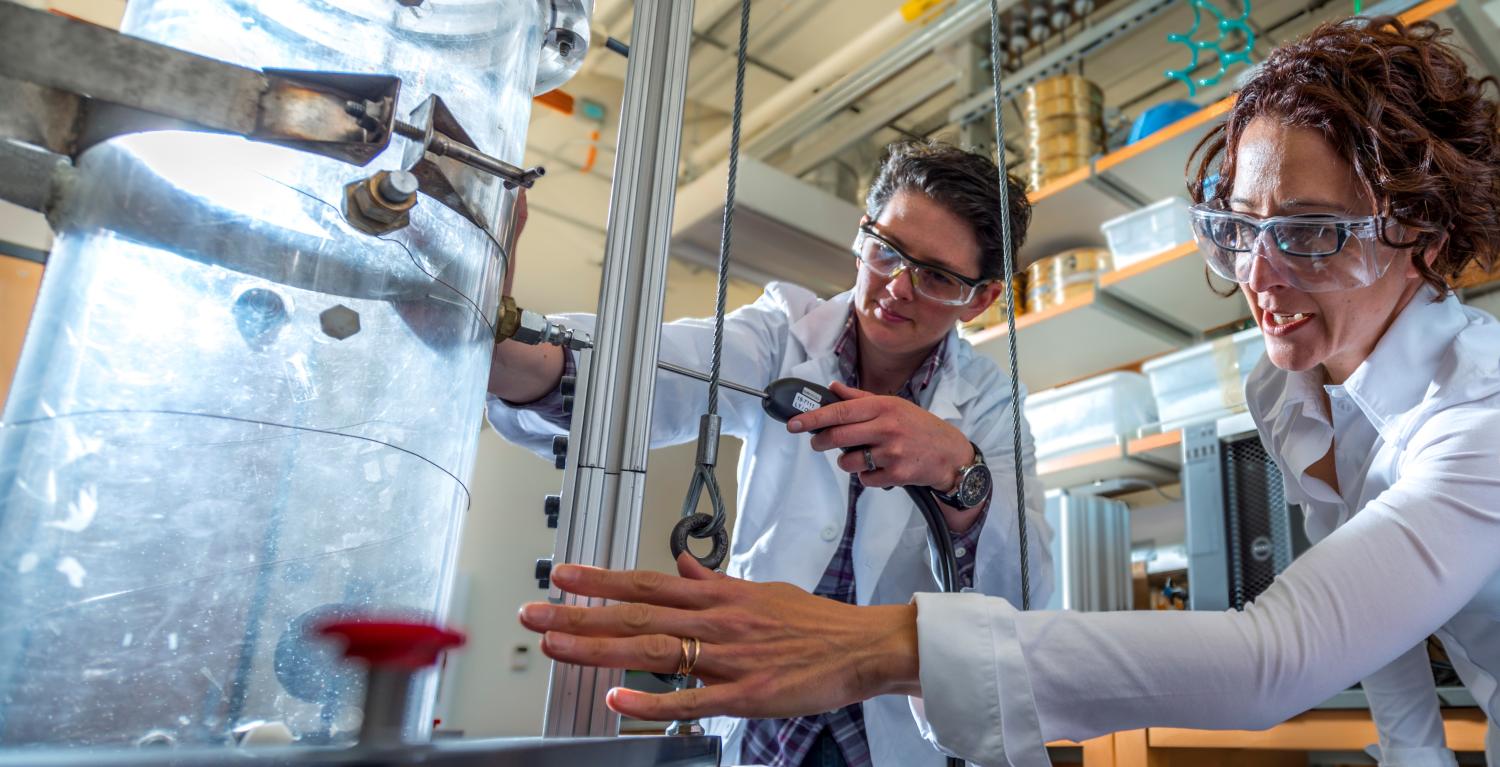Christine Hrenya: Predicting Particle Flows

If you have ever poured flour into a bowl and ended up with a thin layer covering your counter, you understand the difficulty of controlling these small cohesive particles.
What if you were trying to transport 500 pounds of flour through small tubing or fluidize it in a reactor?
“Cohesive particles, where van der Waals forces are stronger than those of gravity, can be difficult to move,” says ChBE Professor Christine Hrenya, who has been investigating granular and complex flow problems for decades. “But they are great fun to model.”
Hrenya’s group has been doing just this for a $1.5 million industry-sponsored grant to simulate cohesive particles in fluidized beds. Because low flow velocities can lead to vertical channeling and high velocities can result in entrainment of agglomerates, flow velocities must be optimized. Hrenya has capability to investigate these flows both computationally and experimentally.
“Collaboration with an external experimental group can involve a significant time lag,” says Hrenya. “About 5 years into my tenure here at CU, I decided to expand my computational group to include experimentalists. This now allows us to test our models as they are being developed and advance the science much more quickly.”
But what if your particles are less like flour and more like sugar? For instance, Hrenya’s group is also investigating using non-cohesive solid particles as a heat transfer fluid in concentrating solar power (CSP) plants. These granular materials are more stable and efficient at higher temperatures than the salt-based fluids currently employed. Though they sometimes form ribbons due to cluster instabilities, Hrenya’s group believes this may actually be good for heat transfer.
“By using something simple, cheap and readily available we can help make solar energy more competitive,” says Hrenya of these DOE- and NSF-supported efforts.
Hrenya has been interested in solid flows since college. “As an undergraduate student, I was always interested in fluid mechanics but never really studied solids as a type of complex fluid. Yet, they are very prevalent in nature – avalanches, the rings of Saturn, transporting grains, pharmaceutical handling. I wanted to start developing general models of solid-based fluids which could be applied to all these different systems. My group is always trying to probe what is happening at the particle level and build up models from there.”
In her simulations, Hrenya utilizes dual approaches: discrete particle simulations (DPS) and continuum models. DPS enables her to model each individual particle and accurately predict flow behavior. However, current supercomputers do not allow for DPS in bigger systems, and so continuum models using DPS results in Navier Stokes-based equations are used to model macroscopic behavior. These continuum model results are then compared to experimental findings.
With computing speed playing such a huge role in the accuracy of her models, Hrenya is partnering with experts in high-performance computing. She and CU Director of Research Computing Thomas Hauser have obtained a DOE grant to merge open source codes to increase their efficiency with a goal of obtaining 108particles in simulations. Hrenya’s models have already been incorporated into a number of commercial and open-source codes such as MFIX and Fluent, earning her the 2014 AICHE PTF Lectureship Award in Fluidization.
In the future, Hrenya believes the adaptation to petascale and exascale computing will enable a new array of questions to be answered. She is open to whatever problems come along, whether in nature, industry or space.
“I have always focused on the fundamental interactions and then let the applications present themselves,” she says. Perhaps this is why her students have gone on to work in a variety of fields, including energy, food, and materials.
Beyond research, Hrenya has won campus-wide awards for her teaching. She spices up fluids and math classes by adding interesting background stories, such as the fact that Stokes almost drove off his fiancé by giving her a 50-page love letter.
Yet Hrenya has much more than particle modeling and teaching on her plate; she is serving as the 2016 AIChE Annual Meeting Chair and also as an Associate Editor for the AIChE Journal. She was interested in the latter position because, “as an editor for the AIChE Journal, I can both help raise the profile of the journal and help authors improve the quality of their individual papers.”
Before agreeing to become the Chair for the 2016 AIChE Annual Meeting, Hrenya asked Dean Rob Davis, a former AIChE Conference Chair himself, for advice. With Davis’s encouragement, Hrenya took on the challenge and is currently in the midst of spearheading new plenary sessions, putting together the technical program, determining awards, and completing a myriad of other tasks.
Learn more:
>>Christine Hrenya to Chair 2016 AIChE Annual Meeting
>>Christine Hrenya Appointed Associate Editor for the AIChE Journal
>>Hrenya to Receive 2014 AICHE PTF Lectureship Award in Fluidization
>>Christine Hrenya Leads $1.5M Industry-sponsored Grant for Fundamental Particle Flow Research
>>Christine Hrenya Wins $686K Grant for Flow Simulations
>>Christine Hrenya Awarded $450K for Solar Power Plant Research

